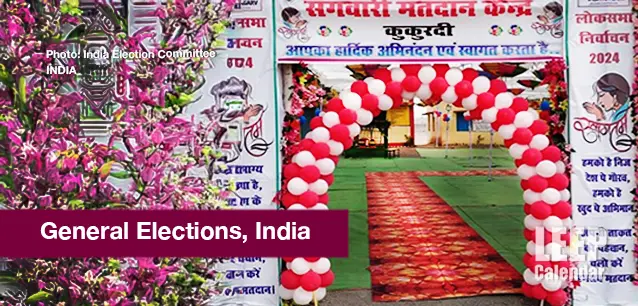 AD
AD
Today is: December 04
Scroll to explore events active on this date.
Additional Events on LEEP
LEEP INK FEATURES

August? Absolutely!
In August, we live through the Dog Days of Summer. It's hot and often humid, and those who can leave for better climates do. Down south, winter is in full force. August is also known as "the ...

In The Heat of July: July 2025 Events
Is it hot enough (or cold enough if you're below the equator) for you yet? There is actually a day for that! Like every month, I pick a diverse collection of events you may or may not know about. This ...

May Blooms: Events in May 2025
Along with October, May is one of the most densely packed months of the year. It's before the summer humidity and the last whole month of the school year. The weather is warming in t...
About India's General Elections
India
Ends: Jun 01, 2024
DESCRIPTION:
INDIA VOTES IN 2024
India, with a population of over 1.3 billion people, of whom 900 million are eligible to vote, is considered the world's largest democracy. Its general elections, held every six years, are a cornerstone of its democratic fabric and have a storied history marked by significant milestones and transformative changes.HISTORY OF INDIA'S ELECTIONS
1951-52: The Dawn of Democracy
India held its first general elections in 1951-52, a monumental event for the newly independent nation. Over 173 million citizens were eligible to vote, and the Indian National Congress (INC), led by Jawaharlal Nehru, emerged victorious, setting the stage for a democratic governance model in the world's largest democracy.
1967: The Era of Coalitions Begins
The fourth general election in 1967 marked a significant shift. Though still in power, the India National Congress witnessed a decline in its dominance, leading to the rise of regional parties and coalition politics. This period saw the political landscape diversify, reflecting the country's complex socio-political fabric.
1977: Democracy Triumphs
The 1977 elections were a watershed moment, held after the controversial Emergency period (1975-77) imposed by then-Prime Minister Indira Gandhi. The electorate responded by voting the India National Congress out of power for the first time, bringing the Janata Party, a coalition of opposition parties, to the forefront. This election underscored the resilience of India's democratic institutions.
1984: A Sympathy Wave
The 1984 general elections followed the assassination of Prime Minister Indira Gandhi. Now led by her son Rajiv Gandhi, the India National Congress won an unprecedented majority, capitalizing on national sympathy. This election highlighted the emotional undercurrents that could influence Indian politics.
1991: Liberalization and Reform
The 1991 elections occurred in the shadow of Prime Minister Rajiv Gandhi's assassination. The India National Congress, led by P.V. Narasimha Rao, returned to power. This period is notable for economic liberalization and significant policy reforms that opened India's economy to global markets, marking a new era of economic transformation.
1998-1999: Coalition Politics and Stability
The late 1990s saw the Bharatiya Janata Party (BJP) emerge as a significant political force. The 1998 and subsequent 1999 elections led to the formation of the National Democratic Alliance (NDA) under the leadership of Atal Bihari Vajpayee. These elections solidified coalition politics as a norm in Indian governance, reflecting the fragmented political mandates of the electorate.
2004: The UPA Era
In 2004, the United Progressive Alliance (UPA), a coalition led by the India National Congress party under the leadership of Sonia Gandhi, won the general elections. Manmohan Singh, an economist and former finance minister, became the Prime Minister. This period saw significant policy initiatives, including introducing the National Rural Employment Guarantee Act (NREGA).
2014: A Modi Wave
The 2014 general elections were a turning point, with the BJP, led by Narendra Modi, winning a decisive mandate. Modi's campaign focused on development, governance, and economic reform, appealing to a broad spectrum of voters. More controversially, he promotes a version of Hindu nationalism that targets minority faiths in the country, primarily India's 200 million Muslims. The BJP's victory marked the first time a non-Congress party secured a majority since 1984.
2019: Consolidating Power
In 2019, the BJP and its allies in the NDA secured another substantial victory, with Modi continuing as Prime Minister. The election underscored the BJP's stronghold in Indian politics, driven by a combination of nationalist rhetoric, development promises, and social welfare initiatives.
Current Landscape
As India moves towards future elections, the political landscape evolves with new players, issues, and dynamics shaping the democratic discourse. Nationalism is on the rise, and throughout Modi's rule, freedom of the press, social justice and civil rights continue to be undermined, suppressed and sidelined. Though billions in advertising dollars continue to be allocated to the current election, voter turnout has been meager. Following June 1, 2024, voters will reveal the future of India's democracy.INDIA'S TOP FIVE POLITICAL PARTIES
India's political landscape is characterized by many parties, each with its unique ideology and base of support. Here is a summary of the five most influential:
1. Indian National Congress (INC)
Founded: 1885
Ideology: Center-left, secularism, social democracy
Key Leaders: Mahatma Gandhi, Jawaharlal Nehru, Indira Gandhi, Rajiv Gandhi, Sonia Gandhi, Rahul Gandhi
Influence: As one of the oldest political parties in India, the INC played a pivotal role in the Indian independence movement. Post-independence, it dominated Indian politics for several decades, spearheading major social and economic reforms. Despite recent electoral setbacks, the INC remains a significant player in national and state politics, advocating for inclusive growth, social justice, and secularism.
2. Bharatiya Janata Party (BJP)
Founded: 1980
Ideology: Right-wing, Hindu nationalism, conservatism
Key Leaders: Atal Bihari Vajpayee, Lal Krishna Advani, Narendra Modi, Amit Shah
Influence: The BJP has emerged as the principal political force in India, especially after its decisive victories in the 2014 and 2019 general elections under Narendra Modi's leadership. The party promotes policies aligned with Hindu nationalist ideals and has focused on economic reforms, national security, and a strong central government. Its influence spans numerous states, making it a dominant force in Indian politics.
3. Communist Party of India (Marxist) [CPI(M)]
Founded: 1964
Ideology: Left-wing, Marxism-Leninism
Key Leaders: E.M.S. Namboodiripad, Jyoti Basu, Prakash Karat, Sitaram Yechury
Influence: The CPI(M) has been a significant player in Indian politics, particularly in states like West Bengal, Kerala, and Tripura. It advocates for workers' rights, land reforms, and social justice, often leading mass movements and strikes. Although its national influence has waned, it remains a potent force in regional politics and continues to shape leftist discourse in India.
4. All India Trinamool Congress (AITC or TMC)
Founded: 1998
Ideology: Center to center-left, populism, regionalism
Key Leaders: Mamata Banerjee
Influence: The TMC, led by Mamata Banerjee, has become a dominant political force in West Bengal. It was formed as a breakaway faction of the INC and has since established itself as a key player in state and national politics. The party focuses on regional issues, social welfare programs, and development, often positioning itself as a staunch opponent of BJP's policies.
5. Bahujan Samaj Party (BSP)
Founded: 1984
Ideology: Social justice, Dalit empowerment, secularism
Key Leaders: Kanshi Ram, Mayawati
Influence: The BSP represents the interests of Dalits, Adivasis, OBCs, and other marginalized communities. Under Mayawati's leadership, it has been a crucial force in Uttar Pradesh, India's most populous state, and has held power there multiple times. The party's focus on social justice and equality has influenced national discourse on caste and marginalization.
These five parties have played critical roles in shaping India's political landscape, each contributing to the country's dynamic and multifaceted democracy.
VIDEOS
SUPPORTING DOCUMENTS
Currently, this event does not have supporting documents.
ADDITIONAL IMAGES
Currently, this event does not have supporting images.
Where would you like to go now?
 AD
AD


/footer-logo.svg)
